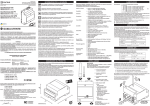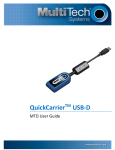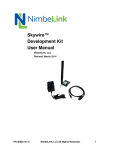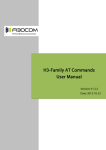Download Easy GPRS User Guide
Transcript
Easy GPRS User Guide 80000ST10028 Rev. 3 - 07/12/07 Easy GPRS User Guide 80000ST10028 Rev. 3 - 07/12/07 This document is relating to the following products: APPLICABILITY TABLE PRODUCT PART NUMBER APPLICABILITY GT864-QUAD 4990150069 √ GT864-PY 4990150070 √ GM862-GPS 3990250657 √ GM862-GPS 3990250689 √ GM862-QUAD-PY 3990250658 √ GM862-QUAD 3990250659 √ GC864-QUAD 3990250675 √ GC864-PY 3990250676 √ GC864-QUAD-C2 3990250681 √ GC864-PY-C2 3990250686 √ GE863-QUAD 3990250653 √ GE863-PY 3990250654 √ GE863-GPS 3990250660 √ GE863-GPS 3990250690 √ GE864-PY 3990250650 √ GE864-QUAD 3990250648 √ SW Version 7.02.03 Reproduction forbidden without Telit Communications S.p.A. written authorization - All Rights Reserved page 2 of 46 Easy GPRS User Guide 80000ST10028 Rev. 3 - 07/12/07 Contents 1 GPRS Operations ............................................................................................................................ 6 1.1 Introduction ............................................................................................................................................6 CSD application example .................................................................................................................................... 8 GPRS application example .................................................................................................................................. 9 1.1.1 1.1.2 1.2 Preliminary GPRS context parameters setting ..................................................................................10 Context parameter setting .................................................................................................................................. 10 Minimum Quality of the Service Requested ...................................................................................................... 11 Requested Quality of the Service ....................................................................................................................... 13 1.2.1 1.2.2 1.2.3 2 1.3 GPRS context activation and data state entering ..............................................................................15 1.4 GPRS data state exit .............................................................................................................................17 Enhanced Easy GPRS Extension ................................................................................................. 18 2.1 Overview ................................................................................................................................................18 2.1 Commands Overview ...........................................................................................................................20 2.1.1 Easy GPRS Outgoing Connection ..................................................................................................................... 20 2.1.1.1 Configuring the GPRS access ................................................................................................................... 21 2.1.1.2 Configuring the embedded TCP/IP stack .................................................................................................. 21 2.1.1.3 Request the GPRS context to be activated ................................................................................................ 22 2.1.1.4 Open the connection with the internet host ............................................................................................... 23 2.1.1.5 Resuming a suspended connection with #SO............................................................................................ 24 2.1.1.6 Close the Socket without deactivating the context .................................................................................... 25 2.1.2 Easy GPRS Incoming Connection ..................................................................................................................... 26 2.1.2.1 Defining the Internet Peer that can contact this device (firewall settings) ................................................ 26 2.1.2.2 Request the socket connection to be opened in listen ............................................................................... 27 2.1.2.3 Accept an incoming connection with #SA ................................................................................................ 28 2.1.2.4 Checking the socket status with #SS ......................................................................................................... 28 2.1.2.5 Using FTP and IP Easy together ............................................................................................................... 29 2.1.2.6 Using CMUX and Multisocket ................................................................................................................. 29 2.1.2.7 4.1 Using old interface command on Multisocket..................................................................................... 30 2.1.2.8 5.1 Dial Up with Multisocket .................................................................................................................... 30 2.1.3 Known limitations.............................................................................................................................................. 30 2.2 FTP OPERATIONS .............................................................................................................................31 Opening and Closing an FTP Connection.......................................................................................................... 31 Setting the FTP Transfer Type ........................................................................................................................... 32 FTP File transfer to the server ........................................................................................................................... 32 FTP File download from the server ................................................................................................................... 33 2.2.1 2.2.2 2.2.3 2.2.4 2.3 AT Commands Compatibility Table...................................................................................................35 2.4 Examples ...............................................................................................................................................36 Easy GPRS - HTTP client application ............................................................................................................... 36 Easy GPRS - EMAIL sending application ......................................................................................................... 38 Easy GPRS -EMAIL receiving application ....................................................................................................... 42 Remote connection between two modules ......................................................................................................... 44 2.4.1 2.4.2 2.4.3 2.4.4 Reproduction forbidden without Telit Communications S.p.A. written authorization - All Rights Reserved page 3 of 46 3 Easy GPRS User Guide 80000ST10028 Rev. 3 - 07/12/07 List of acronyms............................................................................................................................. 45 4 Document Change Log .................................................................................................................. 46 Reproduction forbidden without Telit Communications S.p.A. written authorization - All Rights Reserved page 4 of 46 Easy GPRS User Guide 80000ST10028 Rev. 3 - 07/12/07 DISCLAIMER The information contained in this document is the proprietary information of Telit Communications S.p.A. and its affiliates (“TELIT”). The contents are confidential and any disclosure to persons other than the officers, employees, agents or subcontractors of the owner or licensee of this document, without the prior written consent of Telit, is strictly prohibited. Telit makes every effort to ensure the quality of the information it makes available. Notwithstanding the foregoing, Telit does not make any warranty as to the information contained herein, and does not accept any liability for any injury, loss or damage of any kind incurred by use of or reliance upon the information. Telit disclaims any and all responsibility for the application of the devices characterized in this document, and notes that the application of the device must comply with the safety standards of the applicable country, and where applicable, with the relevant wiring rules. Telit reserves the right to make modifications, additions and deletions to this document due to typographical errors, inaccurate information, or improvements to programs and/or equipment at any time and without notice. Such changes will, nevertheless be incorporated into new editions of this application note. All rights reserved. © 2007 Telit Communications S.p.A. Reproduction forbidden without Telit Communications S.p.A. written authorization - All Rights Reserved page 5 of 46 Easy GPRS User Guide 80000ST10028 Rev. 3 - 07/12/07 1 GPRS Operations 1.1 Introduction The General Packet Radio Services (GPRS) standard permits DATA transfers in a completely different way with respect to previous point to point communications made with Circuit Switch Data (CSD) GSM modems. In CSD operations the modem establishes a connection with the other party (another modem) in such a way that all the Network devices in between are transparent to the data exchanged, simulating a real point to point connection, just as if the other party is directly connected with the controlling application of the modem. The other party can be either an Internet Service Provider (ISP) or a private server, but in any case, the arrival point must have a modem to connect to (Landline, ISDN or GSM CSD). The connection establishment procedure defines a particular path where all the information exchanged between the two peers flows and this path is reserved for exclusive use of these 2 peers for all the time the connection is active. This approach has the drawbacks of a long time to set-up the link between the two peers (up to a minute) and a time counting bill which proceeds even if no data is exchanged because the path resources are reserved anyway; furthermore the speed of the data transfer is limited to 14400 bps. An example of this kind of operation is shown in the following picture, where the point to point connection is between the two peers as if all the devices inside the dashed line are not present: CSD interconnectivity Reproduction forbidden without Telit Communications S.p.A. written authorization - All Rights Reserved page 6 of 46 Easy GPRS User Guide 80000ST10028 Rev. 3 - 07/12/07 In GPRS operations instead, the connection is made directly towards internet as if the GPRS modem was a network IP socket interface. There's no data path reserved for the data exchange between the two peers, instead the resources are allocated dynamically on demand and the data exchanged is organized into packets typically TCP/IP, furthermore the maximum transfer speed can be much faster than GSM CSD. An example of GPRS connection is shown in the following picture, where the GPRS connection is between the GPRS modem and the internet as if all the devices inside the dashed line are not present: GPRS interconnectivity Due to this kind of connection, when activating the GPRS connection you must provide the network parameters to enter through the internet point of the GPRS network ISP (Internet Service Provider) and not the phone number to be dialed; therefore it is not possible to establish a direct point to point GPRS connection between two modems as in CSD case, instead an internet tunneling must be done to achieve a point to point connection between two peers. This approach as the immediate advantage of projecting the controlling application of the GPRS modem directly on the internet, ready to be accessed virtually from anywhere in the world at the same cost on the GPRS; actually the billing of the GPRS connection is based on the amount of data exchanged (number of packets transferred) independently from the time the connection is active or where these packet must be delivered. Therefore, it is possible to leave the controlling application always connected and ready to receive/send data on demand, while paying only for the data really exchanged. The drawback of the GPRS connection is that the controlling application must have its own TCP/IP protocol stack embedded to decode the packets that arrive from GPRS and encode the ones to be sent through the internet. There are few considerations than must be done on the GPRS connections: • the GPRS connection speed with a GPRS class 10 multislot device is asymmetrical, 3 time slots in reception (43200 bps max) and 2 time slot in sending (28800 bps max) or 4 time slots in reception (57600 bps max) and 1 time slot in sending (14400 bps max). Reproduction forbidden without Telit Communications S.p.A. written authorization - All Rights Reserved page 7 of 46 Easy GPRS User Guide 80000ST10028 Rev. 3 - 07/12/07 • The controlling application of the module must have a TCP/IP - PPP software stack to interface with the GPRS modems. • The controlling application must relay on some ISP that may be the Network Operator of the SIM to gain access to the internet through the GPRS connection. • Because of the point before, the receiving application must have internet access either. • Since the communication is based upon TCP/IP packets, then it is possible to talk contemporarily with more than one peer. • When required, the data security in internet shall be guaranteed by security protocols over the TCP/IP that must be managed by the controlling application. A modem can be in 4 different states: • GPRS DETACHED, which corresponds to the "not reachable" condition for the GPRS service; • GPRS ATTACHED, which corresponds roughly to the "registered" condition for the GPRS service; • GPRS context activated, which corresponds to the “reachable on the network” condition with IP address assigned (this is possible with AT command: AT#GPRS=1 and also some other AT commands) • CONNECTED, which roughly corresponds to the connected status; A thing that must be noted on the GPRS connect, is the fact that, if the mobile IP address (the internet address) is assigned by the ISP dynamically, then when the GPRS context of the device is not activated it has no address and therefore it cannot be reached by internet requests. The same thing occurs in the case the GPRS device has a static IP address assigned to it by the ISP, but it is DETACHED. In these cases there's no possibility for the internet peer to "call" the GPRS device through internet, the only way to alert it is to call it in GSM mode (either a Data or a Voice call are suited) and the GPRS module application must recognize the caller, eventually abort the GSM call and connect to the internet in GPRS to receive the packets from the internet peer. NOTE: Mobile device can be reachable from internet network only if the IP assigned by the operator is public IP; not all operators offer this service. To explain further the differences between CSD and GPRS an example application made in both ways will be shown. 1.1.1 CSD application example Let’s suppose you have several remote meteorological measurement units spread around the territory, and you want to access them wirelessly through a GSM module in CSD operation. For each remote unit, there's a modem to connect with the server application, with its own SIM card and unique phone number. Now there are two possibilities: • the server application calls on demand the remote units, provided it has stored their phone numbers in a private database. Reproduction forbidden without Telit Communications S.p.A. written authorization - All Rights Reserved page 8 of 46 Easy GPRS User Guide 80000ST10028 Rev. 3 - 07/12/07 • the remote units call the server application modem when needed and eventually retry in the case they found it busy; this time the phone number to be stored is only one, the server number which must be stored on the remote units. In both cases, once connected, the remote unit sends the meteorological data to the server, which places it in a central database for further reading by anyone who accesses the meteorological internet site for example. The drawback of this approach is that the CSD modem needs about 30s to establish the connection and, depending on the amount of data to be transferred (usually few hundred bytes), some seconds to transfer them. So let’s say we pay a 40s call while we need only 10s to transfer data. 1.1.2 GPRS application example The same application can be done by all the Telit modules using the GPRS feature. The remote unit is always connected to the internet taking advance of the features of the GPRS system, when it needs to send data to the server application it simply fills the TCP/IP packets for the server with the meteorological data and gives them to the Telit module to deliver. The central server has a single modem to connect to the internet, receives the TCP/IP packets from all the remote units and places the contained data in the central database. The advantage of using GPRS is that the remote unit is always connected and reachable and it pays only for the amount of data (small) transferred and not for the connection time as in CSD operations; in addiction the call billing is equal for devices placed anywhere in the Network Operator State and the server can be anywhere in the World. Furthermore, in the CSD operation the server shall have a set of modems and multiple phone lines to ensure that the calling units will not find it busy, while a single modem is enough for GPRS operation. The speed at which the packets can be downloaded is up to 57600 bps (class 10 device working at 4+1), 4 times faster than CSD. In the following paragraphs more detailed information will be given on how to establish GPRS connection. Reproduction forbidden without Telit Communications S.p.A. written authorization - All Rights Reserved page 9 of 46 Easy GPRS User Guide 80000ST10028 Rev. 3 - 07/12/07 1.2 Preliminary GPRS context parameters setting 1.2.1 Context parameter setting The context parameters are all the set of information to identify the internet entry point interface provided by the ISP. With these parameters the GPRS network identifies the ISP to be used to gain access to the internet and defines the value of the IP address of the GPRS device once connected. • send command AT+CGDCONT[=[<cid>[,<PDP_type>[,<APN>[,<PDP_addr>[,<d_comp>[,<h_comp>[,<pd 1>[,…[,pdN]]]]]]]]]]<cr> where: <cid> - (PDP Context Identifier) numeric parameter which specifies a particular PDP context definition. 1..max - where the value of max is returned by the Test command <PDP_type> - (Packet Data Protocol type) a string parameter which specifies the type of packet data protocol "IP" - Internet Protocol "PPP" - Point to Point Protocol <APN> - (Access Point Name) a string parameter that represents logical name used to select GGSN or external packet data network. If the value is null or omitted, then the subscription value will be requested. <PDP_addr> - a string parameter that identifies the terminal in the address space applicable to the PDP. The allocated address may be read using the +CGPADDR command. <d_comp> - numeric parameter that controls PDP data compression 0 - off (default if value is omitted) 1 - on <h_comp> - numeric parameter that controls PDP header compression 0 - off (default if value is omitted) 1 - on <pd1>, …, <pdN> - zero to N string parameters whose meanings are specific to the <PDP_type> NOTE: a special form of the Set command, +CGDCONT=<cid>, causes the values for context number <cid> to become undefined. NOTE: issuing AT+CGDCONT<CR> is the same as issuing the Read command. NOTE: issuing AT+CGDCONT=<CR> returns the OK result code. Reproduction forbidden without Telit Communications S.p.A. written authorization - All Rights Reserved page 10 of 46 Easy GPRS User Guide 80000ST10028 Rev. 3 - 07/12/07 • wait for response: Response OK ERROR Reason context parameters have been successfully stored some error occurred Action proceed ahead check parameters and retry For example: 1- Let's assume you want to set-up the GPRS context number 1(cid) with your GPRS connection parameters APN: ibox.tim.it IP address: dynamically assigned by the ISP Packet Data Protocol type: Internet Protocol (IP) Data compression: OFF Header compression: OFF command: AT+CGDCONT= 1,"IP","ibox.tim.it","0.0.0.0",0,0 <cr> response OK 1.2.2 Minimum Quality of the Service Requested The minimum quality of service requested parameters represent the boundary under which the connection quality is not anymore acceptable and will be terminated. • send command AT+CGQMIN=<cid>,<precedence>,<delay>,<reliability>,<peak>,<mean><cr> where: <cid> - is the index number of the desired context to be written (up to 5 different context). <precedence> - is the precedence class. It is applied when the network has a heavy duty and user precedence must be followed to ensure operations, the higher the priority the better the service. 0 - subscribed (default) 1 - High priority 2 - Normal priority 3 - Low priority <delay> - is the delay class. It represents the maximum allowable time delay class between the sending and the reception of a packet. Reproduction forbidden without Telit Communications S.p.A. written authorization - All Rights Reserved page 11 of 46 Easy GPRS User Guide 80000ST10028 Rev. 3 - 07/12/07 0 - subscribed (default) 1 - delay class 1 2 - delay class 2 3 - delay class 3 4 - delay class 4 (best effort) <reliability> - is the connection reliability class. It represents the connection reliability requested, the higher is the number the less reliable is the data exchanged. 0 - subscribed (default) 1 - reliability class 1 (acknowledged GTP,LLC and RLC; protected data) 2 - reliability class 2 (unacknowledged GTP, acknowledged LLC and RLC; protected data) 3 - reliability class 3 (unacknowledged GTP and LLC, acknowledged RLC; protected data) 4 - reliability class 4 (unacknowledged GTP,LLC and RLC; protected data) 5 - reliability class 5 (unacknowledged GTP,LLC and RLC; unprotected data) <peak> - is the peak data transfer throughput 0 - subscribed (default) 1 - up to 7,8 kbps 2 - up to 15,6 kbps 3 - up to 31,3 kbps 4 - up to 62,5 kbps 5 - up to 125 kbps 6 - up to 250 kbps 7 - up to 500 kbps 8 - up to 1000 kbps 9 - up to 2000 kbps <mean> - is the mean data transfer throughput 0 - subscribed (default) 1 - up to 0,8 kbps 2 - up to 1,6 kbps 3 - up to 3,9 kbps 4 - up to 7,8 kbps 5 - up to 15,6 kbps 6 - up to 39 kbps 7 - up to 78 kbps 8 - up to 156 kbps 9 - up to 390 kbps 10 - up to 7,6 Mbps 11 - up to 15.2 Mbps 12 - up to 38.2 Mbps 13 - up to 76.3 Mbps 14 - up to 152 Mbps 15 - up to 381 Mbps 16 - up to 762 Mbps 17 - up to 1525 Mbps 18 - up to 3815 Mbps Reproduction forbidden without Telit Communications S.p.A. written authorization - All Rights Reserved page 12 of 46 Easy GPRS User Guide 80000ST10028 Rev. 3 - 07/12/07 31 - Best Effort • wait for response: Response OK ERROR Reason context parameters have been successfully stored some error occurred Action proceed ahead check parameters and retry. NOTE: If your minimum requirements are too high, then it can happen that it is impossible to establish a GPRS connection, because the network has not enough resources to guarantee that quality of service. If does this happen, then you shall try reducing your minimum quality requirements. For example: 1- Let's assume you want to set-up the GPRS context number 1(cid) written before with your GPRS min QoS parameters: Precedence class: Normal priority Delay class: subscribed Reliability class: subscribed Peak throughput: not less than 15,6 kbps Mean throughput: not less than 7,8 kbps command: AT+CGQMIN= 1,2,0,0,5,4 <cr> response OK NOTE: Telit suggests to setup AT+CGQMIN=1,0,0,0,0,0 1.2.3 Requested Quality of the Service The requested quality of service parameters represents the connection quality that is requested to the network on GPRS context activation. • send command AT+CGQREQ=<cid>,<precedence>,<delay>,<reliability>,<peak>,<mean><cr> where: <cid> - is the index number of the desired context to be written (up to 5 different context). Reproduction forbidden without Telit Communications S.p.A. written authorization - All Rights Reserved page 13 of 46 Easy GPRS User Guide 80000ST10028 Rev. 3 - 07/12/07 <precedence> - is the precedence class <delay> - is the delay class <reliability> - is the connection reliability class <peak> - is the peak data transfer throughput <mean> - is the mean data transfer throughput Parameters assume the same values as in the previous section. • wait for response: Response OK ERROR Reason context parameters have been successfully stored some error occurred Action proceed ahead check parameters and retry For example: 1- Let's assume you want to set-up the GPRS context number 1(cid) written before with your GPRS requested QoS parameters: Precedence class: High priority Delay class: subscribed Reliability class: subscribed Peak throughput: subscribed Mean throughput: best effort command: AT+CGQREQ= 1,1,0,0,0,31 <cr> response OK NOTE: Telit suggests to setup AT+CGQMIN=1,0,0,3,0,0 Reproduction forbidden without Telit Communications S.p.A. written authorization - All Rights Reserved page 14 of 46 Easy GPRS User Guide 80000ST10028 Rev. 3 - 07/12/07 1.3 GPRS context activation and data state entering This operation corresponds to dial and connect operations in case of a CSD GSM data call has been issued to an internet service provider. • send command ATD*99***<cid>#<cr> where: <cid> - is the index number of the desired context to be used (up to 5 different context) • wait for response: Response CONNECT Reason GPRS connection is being processed ERROR some error occurred +CME ERROR: <error code> some error occurred Action proceed ahead with the authentication & Packed data protocol check context parameters and retry. See par. 1.2.1, 1.2.2, 1.2.3 check also Network registration status. check context parameters and retry. See par. 1.2.1, 1.2.2, 1.2.3 check also Network registration status. For example: 1- Let's assume you want to activate and enter the GPRS state with context number 1(cid) written before with your GPRS requested QoS parameters: command: ATD*99***1# <cr> response CONNECT At this point, your application should start the PPP protocol with the LCP Exchange phase: Î LCP Configure Request Reproduction forbidden without Telit Communications S.p.A. written authorization - All Rights Reserved page 15 of 46 Easy GPRS User Guide 80000ST10028 Rev. 3 - 07/12/07 Í LCP Configure Acknowledge Î PAP Authentication Í PAP-Ack Î NCP (IP) Configure Request Í NCP (IP) Configure Acknowledge At this point the TCP/IP - PPP protocol stack is up and data packets can be exchanged. NOTE: Explanation of TCP/IP and PPP protocol stack is beyond the scope of this document. Further information on the LCP protocol and PPP protocol definition can be found in the RFC1661. Further information on the PAP protocol definition can be found in the RFC1334. Further information on the IPCP protocol definition can be found in the RFC1332. NOTE: The CONNECT result code is raised before complete GPRS connection establishment. Reproduction forbidden without Telit Communications S.p.A. written authorization - All Rights Reserved page 16 of 46 Easy GPRS User Guide 80000ST10028 Rev. 3 - 07/12/07 1.4 GPRS data state exit Î LCP Terminate Request Í LCP Terminate Acknowledge • Wait for NO CARRIER response. or in alternative: • send escape sequence: +++ • wait for 2s ( default silence time) • wait for response: Response OK • ERROR Reason Telit module is in command mode now some error occurred NO CARRIER connection has been closed Action proceed ahead check command syntax and timing and retry proceed ahead send command ATH<cr> • wait for response: Response OK ERROR Reason GPRS connection has been closed some error occurred Action check command syntax and retry Reproduction forbidden without Telit Communications S.p.A. written authorization - All Rights Reserved page 17 of 46 Easy GPRS User Guide 80000ST10028 Rev. 3 - 07/12/07 2 Enhanced Easy GPRS Extension 2.1 Overview The Easy GPRS feature allows the Telit module users to contact a device in internet and establish with it a raw data flow over the GPRS and Internet networks. This feature can be seen as a way to obtain a "virtual" serial connection between the Application Software on the Internet machine involved and the controller of the Telit module, regardless of all the software stacks underlying. An example of the protocol stack involved in the devices is reported: Virtual Serial Link Local Application EASY GPRS Serial Line Driver Remote Application EASY GPRS Data on Board V. 24 V. 24 Controller Device Telit‘s Module TCP/UDP IP IP IP TCP/UDP IP L2 L2 Network Interworking L1 GPRS Network and Internet Reproduction forbidden without Telit Communications S.p.A. written authorization - All Rights Reserved L1 Remote Device page 18 of 46 Easy GPRS User Guide 80000ST10028 Rev. 3 - 07/12/07 This particular implementation allows to the devices interfacing to the Telit module the use of the GPRS and Internet packet service without the need to have an internal TCP/IP stack since this function is embedded inside the module. New functionality of the Telit modules, multisocket is an extension of Telit Easy GPRS feature, which allows the user to have two contexts activated (that means two different IP address), more than one socket connection (with a maximum of 6) and simultaneous FTP client and EMAIL client service. The basic idea of multisocket is the possibility of suspend a socket connection with the escape sequence +++. With IP Easy we can use the command #SD to open a socket connection and go online. When the online activities are concluded we use +++ sequence to close the connection (see the figure below). Online mode Data Traffic On Line +++ The green part represents the module command mode while the red part is the online mode. Now, the online mode can be suspended with the escape sequence by using the multisocket feature. During suspend mode the data received by the socket will be buffered. These data will be displayed after socket resumption, as shown in the figure below: Socket is still alive Data Data On Line Suspend On Line Suspend This new feature allows users to switch between online mode and command mode without closing the connection and eventually opening another socket (or resuming the suspended one), FTP or EMAIL connection. Reproduction forbidden without Telit Communications S.p.A. written authorization - All Rights Reserved page 19 of 46 Easy GPRS User Guide 80000ST10028 Rev. 3 - 07/12/07 Another new feature is the possibility to associate any socket connection to a specific context, this means that we can use different IP addresses for the connections (max 2). Socket identifier is called Connection Id (selects which socket we want to use from 1 up to 6) and every Connection Id is associated to a context. 2.1 Commands Overview In the following paragraphs you can find new AT commands sequence that activates GPRS context, sets and opens the socket connection. You can also find the explanation regarding new listen command and how to use FTP and IP Easy at the same time. NOTE: For more detailed AT commands and parameters definitions remember to consult the AT Commands Reference Guide 2.1.1 Easy GPRS Outgoing Connection The Easy GPRS feature provides a way to place outgoing TCP/UDP connections and keep the same IP address after a connection, leaving the GPRS context active. The steps required to open a socket and close it without closing the GRPS context are: • • • • • • • configuring the GPRS Access configuring the embedded TCP/IP stack behaviour defining the Internet Peer to be contacted request the GPRS context to be activated request the socket connection to be opened exchange data close the TCP connection while keeping the GPRS active All these steps are achieved through AT commands. As for common modem interface, two logical statuses are involved: command mode and data traffic mode. • • In Command Mode (CM), some AT commands are provided to configure the Data Module Internet stack and to start up the data traffic. In data traffic mode (Socket Mode, SKTM), the client can send/receive a raw data stream which will be encapsulated in the previously configured TCP / IP packets which will be sent to the other side of the network and vice versa. Control plane of ongoing socket connection is deployed internally to the module. Reproduction forbidden without Telit Communications S.p.A. written authorization - All Rights Reserved page 20 of 46 Easy GPRS User Guide 80000ST10028 Rev. 3 - 07/12/07 2.1.1.1 Configuring the GPRS access The GPRS access configuration is done by setting: • • the GPRS context number 1 parameters (see +CGDCONT command) the Authentication parameters: User Name and Password (see command #SGACT) 2.1.1.2 Configuring the embedded TCP/IP stack The TCP/IP stack behaviour must be configured by setting: • • • the packet default size the data sending timeout the socket inactivity timeout Before opening a connection we have to set the socket parameters with the new #SCFG command. It is possible to set all the timeout values and packet size for each socket connection with a single AT command. The command syntax is: AT#SCFG = <Conn Id>, <Cntx Id>, <Pkt sz>, <Global To>, <Conn To>, <Tx To> Where: • • • • • • Conn Id -the connection identifier Cntx Id -the context identifier Pkt sz -the minimum data packet sent to the net (default 300 bytes) Global To -inactivity timeout (default 90 sec.) Conn To -connection timeout (default 60 sec, expressed in tenths of second) Tx To -data sending timeout (default 5 sec, expressed in tenths of second) The first two parameters are new and they represent the association between the socket connection and the context set with +CGDCONT. It means that we can have socket connection working on different IP addresses. The other parameters replace the old IP Easy commands #DSTO, #SKTTO, #SKTCT and #PKTSZ. If we try to modify the socket configuration of an online connection an error will appear. So it’s recommended to set the socket configuration at the beginning. It is strongly recommended to leave the first Connection Id associated to context one to allow simultaneous FTP, SMTP and IPEasy services. The values set with this command are saved in NVM. Reproduction forbidden without Telit Communications S.p.A. written authorization - All Rights Reserved page 21 of 46 Easy GPRS User Guide 80000ST10028 Rev. 3 - 07/12/07 Example: We want to associate the Connection Id number 2 to the context number 3 with a minimum packet size of 512 bytes, global timeout of 30 sec, connection timeout of 30 sec and transmission timeout of 10 sec. Command: AT#SCFG = 2, 3, 512, 30, 300,100 Answer: OK if command execution is correct ERROR if a parameter is wrong or the connection Id is working online 2.1.1.3 Request the GPRS context to be activated This command allows activation of one of the contexts defined with AT command +CGDCONT. With multisocket it is possible to activate simultaneously two context of the five that have been set. We can write username and password directly from command line (if required). At least one Connection Id must be associated to the context we want to activate otherwise an error will be appear. The command syntax is: #SGACT: <Cntx Id>,<Status>, [<Username>],[<Password>] Where: • • Cntx Id is the context that we want to activate/deactivate. Status is the context status (0 means deactivation, 1 activation). Example: We want to activate context number two defined with +CGDCONT. Command: AT#SGACT = 2,1 Answer: #SGACT: “212.195.45.65” OK if activation success. ERROR if activation fails. Reproduction forbidden without Telit Communications S.p.A. written authorization - All Rights Reserved page 22 of 46 Easy GPRS User Guide 80000ST10028 Rev. 3 - 07/12/07 The response code to the AT#SGACT=1 command reports the IP address obtained from the network, allowing the user to report it to his server or application. Deactivating the context implies freeing the network resources previously allocated to the device. 2.1.1.4 Open the connection with the internet host With the AT command #SD (socket Dial) the TCP/UDP request to connect with the internet host starts: • • DNS query is done to resolve the IP address of the host name internet peer if required Telit module establishes a TCP/UDP (depending on the parameter request) connection with the given internet host Once the connection is up the module reports the code: CONNECT • The command syntax is: AT#SD = <Conn Id>,<Protocol>, <Remote Port>, <IP address> [, <Closure Type> [, <Local Port>]] Where: • • • • Conn Id is the connection identifier. Protocol is 0 for TCP and 1 for UDP. Remote Port is the port of the remote machine. IP address is the remote address. To open the remote connection the context to which the Connection Id is associated must be active, otherwise an error will appear. For example if we want to connect to a web server with Connection Id number 3 the command is: AT#SD = 3 , 0 , 80 , “www.telit.com” If the command is successful we’ll have a CONNECT message, and the socket number 3 will be connected to the Telit web server. From this moment the data incoming in the serial port is packet and sent to the Internet host, while the data received from the host is serialised and flushed to the Terminal Equipment. The +++ sequence does not close the socket, but only suspends it. We can suspend the connection and open another one with a different Connection Id. A typical command sequence is: AT#SD = 3 , 0 , 80 , “www.telit.com” CONNECT (send, receive data….) Reproduction forbidden without Telit Communications S.p.A. written authorization - All Rights Reserved page 23 of 46 Easy GPRS User Guide 80000ST10028 Rev. 3 - 07/12/07 (+++) OK OK is returned after the escape sequence, it means that the socket has been suspended correctly. Now the connection number 3 is suspended and the module is in command mode so we can give another #SD command. AT#SD = 2 , 0 , 80 , “www.google.com” CONNECT (send, receive data….) (+++) OK If we try to open a connection while the ConnId is in suspended state or online an error will be occur. If a suspended connection receives some data the user will receive an unsolicited SRING indication from the module. In case we receive some data from the suspended connection with Telit server we’ll receive this unsolicited message: SRING: 3 where 3 is the number of the ConnId with data pending. NOTE: The unsolicited SRING indication appears only in command mode. 2.1.1.5 Resuming a suspended connection with #SO This is the new command to resume a suspended connection, the command syntax is: AT#SO = <Conn Id> Example: AT#SD = 2 , 0 , 80 , “www.google.com” CONNECT data sending (+++) OK SRING: 2 AT#SO = 2 CONNECT Reproduction forbidden without Telit Communications S.p.A. written authorization - All Rights Reserved page 24 of 46 Easy GPRS User Guide 80000ST10028 Rev. 3 - 07/12/07 data sending (+++) In case there is data pending on this socket (you can know this the unsolicited message SRING has appeared before), issuing command AT#SO these pending data will be displayed after the CONNECT string. It is possible to resume a suspended socket without waiting for SRING message or data pending on that connection. Using AT#SO on a Connection Id in idle state (no socket open or suspended) we obtain a NO CARRIER message. 2.1.1.6 Close the Socket without deactivating the context The connection can be closed for the following reasons: • • • • remote host TCP connection close socket inactivity timeout Terminal Equipment by issuing the escape sequence "+++" and AT#SH that specifies the Connection Id Network deactivation With the new management of the escape sequence we need a command to close the socket connection. The AT command syntax to use is: AT#SH = <conn Id> Example: AT#SD = 2 , 0 , 80 , “www.google.com” CONNECT data sending (+++) OK AT#SH = 2 OK Now the connection is closed. If we send this command with an idle Connection Id we obtain in any case an OK message. Reproduction forbidden without Telit Communications S.p.A. written authorization - All Rights Reserved page 25 of 46 Easy GPRS User Guide 80000ST10028 Rev. 3 - 07/12/07 NOTE: if there is an escape sequence in the raw data to be sent, then the TE must work it out and sent it in a different fashion to guarantee that the connection is not closed. The pause time is defined in the parameter S12. To avoid sending of the escape sequence a command AT#SKIPESC should be set at the beginning. 2.1.2 Easy GPRS Incoming Connection The Easy GPRS feature provides a way to accept incoming TCP/UDP connections and keep the same IP address after a connection, leaving the GPRS context active. The steps that will be required to open a socket in listen, waiting for connection requests from remote hosts and accept these request connections only from a selected set of hosts, then close it without closing the GRPS context are: • • • • • • • • configuring the GPRS Access configuring the embedded TCP/IP stack behaviour (see par. 2.1.1.2) defining the Internet Peer that can contact this device (firewall settings) (see par. 2.1.2.1) request the GPRS context to be activated (see par. 2.1.1.3) request the socket connection to be opened in listen (see par. 2.1.2.2) receive connection requests (see par. Error! Reference source not found.) exchange data close the TCP connection while keeping the GPRS active (see par. 2.1.1.6) All these steps are achieved through AT commands. As for common modem interface, two logical statuses are involved: command mode and data traffic mode. • • In Command Mode (CM), some AT commands are provided to configure the Data Module Internet stack and to start up the data traffic. In data traffic mode (Socket Mode, SKTM), the client can send/receive a raw data stream which will be encapsulated in the previously configured TCP / IP packets which will be sent to the other side of the network and vice versa. Control plane of ongoing socket connection is deployed internally to the module. 2.1.2.1 Defining the Internet Peer that can contact this device (firewall settings) The Telit module has an internal Firewall that controls the behaviour of the incoming connections to the module. The firewall applies for INCOMING (listening) connections; OUTGOING connections will be always done regardless of the firewall settings. Firewall General policy is DROP, therefore all packets that are not included into an ACCEPT chain rule will be silently discarded. When packet incomes from the IP address <incoming IP>, the firewall chain rules will be scanned for matching with the following criteria: Reproduction forbidden without Telit Communications S.p.A. written authorization - All Rights Reserved page 26 of 46 Easy GPRS User Guide 80000ST10028 Rev. 3 - 07/12/07 <incoming IP> & <net mask> = <ip_address> ? if the result is yes, then the packet is accepted and the rule scan is finished, otherwise the next chain is taken into account until the end of the rules when the packet is silently dropped if no matching was found. For example, let’s assume we want to accept connections only from our devices which are on the IP addresses ranging from 197.158.1.1 to 197.158.255.255 We need to add the following chain to the firewall: AT#FRWL=1,"197.158.1.1","255.255.0.0" 2.1.2.2 Request the socket connection to be opened in listen The new listen command is now extended to 6 connections; it’s possible to set from 1 to 6 socket listening on a specific port for the incoming connections. Another difference with the old IP Easy is that now we receive an unsolicited indication when someone tries to connect, so we can decide to accept (AT#SA) or refuse (AT#SH) the incoming connection. NOTE: In case you decide to reject an incoming connection request the listening socket will be closed and if you want to re-open it the AT command AT#SL needs to be re-issued. The command syntax is: AT#SL = <Conn Id>, <Listen state>, <Listen port>[, <Closure Type>] It’s not possible to have two ConnId listening on the same port. Example: Suppose that we want to listen on port 6543 Connection Id number 2 AT#SL = 2, 1, 6543 OK Now the module is listening for incoming connection on port 6543 with Connection Id number 2, if a remote host is trying to connect we’ll receive a SRING unsolicited indication with the listening Connection Id: SRING: 2 Reproduction forbidden without Telit Communications S.p.A. written authorization - All Rights Reserved page 27 of 46 Easy GPRS User Guide 80000ST10028 Rev. 3 - 07/12/07 2.1.2.3 Accept an incoming connection with #SA After receiving the SRING indication for an incoming connection we can decide to refuse the remote host connection with #SH command or accept the connection with #SA command. The command syntax is: AT#SA = <conn Id> Example: We are listening on Connection Id 3 and port 6543 AT#SL = 3, 1, 6543 OK A remote host is trying to connect, we receive the unsolicited indication. SRING: 3 Now we accept the connection AT#SA = 3 CONNECT We pass in online mode and the connection is established. With the escape sequence we suspend the socket and the module is back to command mode. To resume the suspended connection we can use the #SO command described above. 2.1.2.4 Checking the socket status with #SS With the old IP Easy socket connection the possible states were: online state or closed, while with multisocket suspension we have other socket states. With the new command AT#SS we can see the status of all the six sockets. The command syntax is: AT#SS Suppose that we have suspended some sockets and we are in command mode, in order to verify which Connection Id has been opened, we can use AT#SS command to have a snapshot of sockets status. The command result is: Reproduction forbidden without Telit Communications S.p.A. written authorization - All Rights Reserved page 28 of 46 Easy GPRS User Guide 80000ST10028 Rev. 3 - 07/12/07 #SS: <ConnId>,<Status>,<Local IP>,<Local Port>,<Remote IP>,<Remote Port> For every Connection Id with have the information about our local IP address, local port, remote IP and port if we are connected. The Status field represents the socket status: 0 – Socket Closed. 1 – Socket with an active data transfer connection. 2 – Socket suspended. 3 – Socket suspended with pending data. 4 – Socket listening. 5 – Socket with an incoming connection. Waiting for the user accept or shutdown command. Example: AT#SS #SS: 1,4,217.201.131.110,21 #SS: 2,2,217.201.131.110,1033,194.185.15.73,10510 #SS: 3,3,217.201.131.110,1034,194.185.15.73,10510 #SS: 4,1,217.201.131.110,1035,194.185.15.73,10510 #SS: 5,0 #SS: 6,0 OK In this case we can see Connection Id 1 in listen mode on port 21, number 2 suspended with no data pending, number 3 suspended with pending data and number 1 is online. The last two connections are closed 2.1.2.5 Using FTP and IP Easy together Another new functionality of multisocket is the simultaneous FTP client service with socket connections. We can use socket suspension mode to give FTP commands as in the old IP Easy, keeping socket alive and eventually resuming socket connections when we need to. Note: It is recommended to leave Connection Id 1 associated to context 1 for using this functionality. ( for more explanation see also paragraph 2.1.1.2) 2.1.2.6 Using CMUX and Multisocket Using CMUX we can have up to three virtual port to execute normal AT commands; if we join CMUX with multisocket we can share the six connections on the three ports (six is the total number in any case) and we can have up to three sockets active (online) at the same time. Reproduction forbidden without Telit Communications S.p.A. written authorization - All Rights Reserved page 29 of 46 Easy GPRS User Guide 80000ST10028 Rev. 3 - 07/12/07 FTP with CMUX is locked on the opening port. So if we try to open an FTP client connection on another virtual port the FTP commands will show an error message until the first connection with FTP server is not closed. When the connection is closed we can open another FTP session on another virtual port. In any case we can always have only one FTP session opened at the time. 2.1.2.7 4.1 Using old interface command on Multisocket The old commands like #SKTD or #SKTL are available also on multisocket platform and they work like in the old IP Easy platform. If we open a connection with #SKTD we can’t suspend the connection, and the +++ sequence will close definitively the connection. In particular with #SKTD command we have the possibility to open three simultaneous connections using CMUX virtual ports. They are closed using the +++ sequence. Note: #SKTOP has some limitations. It is available only on the first virtual port of CMUX and it is recommended not to use it with the new multisocket commands because #SKTOP deactivates the context when the connection is closed. This can generate the closure of suspended sockets. It’s strongly recommended in any case to avoid using old IP Easy command with new multisocket commands. 2.1.2.8 5.1 Dial Up with Multisocket With multisocket we recommend you to use the first context for a dialup connection and use the other available context for IP Easy socket connection. The first context must be deactivated to make dialup connection work correctly, if we activate IP Easy and dialup at the same time the performance get worse. It is possible to make web browsing and IP Easy socket connection at the same time. 2.1.3 Known limitations The implementation of the EASY GPRS feature has the following known limitations: • • • #SKTOP is available only on the first virtual port of CMUX PPP and IPEasy functionalities not on the same IP Address (PPP uses always the first Cntx Id) Multi listen only on different IP ports Reproduction forbidden without Telit Communications S.p.A. written authorization - All Rights Reserved page 30 of 46 Easy GPRS User Guide 80000ST10028 Rev. 3 - 07/12/07 2.2 FTP OPERATIONS A set of AT commands is available to support the FTP activities. The first command is called #FTPTO (FTP Time-Out) which defines the time-out for FTP operations. The module has already a factory default time defined that is 10 s. If it is needed to be modified, the syntax is: AT#FTPTO[=<tout>] Parameter: <tout> - time-out in 100 ms units 100..5000 - hundreds of ms (factory default is 100) NOTE: The parameter is not saved in NVM. NOTE: if parameter <tout> is omitted the behaviour of Set command is the same as Read command. Example: AT#FTPTO=1000<cr> OK (set the timeout to 100sec) 2.2.1 Opening and Closing an FTP Connection With the command AT#FTPOPEN=<server:port>,<username>,<password>,<mode> is possible to open the FTP connection. The parameters are: <server:port> - string type, address and port of FTP server (factory default port 21). <username> - string type, authentication user identification string for FTP. <password> - string type, authentication password for FTP. <mode> 0 - active mode (default) 1 - passive mode In order to close the FTP connection the AT command AT#FTPCLOSE should be used. Reproduction forbidden without Telit Communications S.p.A. written authorization - All Rights Reserved page 31 of 46 Easy GPRS User Guide 80000ST10028 Rev. 3 - 07/12/07 2.2.2 Setting the FTP Transfer Type With the command AT#FTPTYPE[=<type>] is possible to configure the file transfer type. The command must be provided during an FTP connection. Parameter: <type> - file transfer type: 0 - binary 1 - ASCII NOTE: The command causes an ERROR result code to be returned if no FTP connection has been opened yet. NOTE: If the parameter is omitted then the behaviour of Set command is the same of Read command. 2.2.3 FTP File transfer to the server With the command AT#FTPPUT=<filename> , to issued during an FTP connection, is possible to open a data connection and starts sending <filename> file to the FTP server. If the data connection succeeds, a CONNECT indication is sent, otherwise a NO CARRIER indication is sent. Parameter: <filename> - string type, name under which you choose to save the file on the server (must have the right extension: es. if the file you’re sending is .txt then the <filename> can be test.txt) NOTE: use the escape sequence +++ to close the data connection. NOTE: The command causes an ERROR result code to be returned if no FTP connection has been opened yet. Example of an FTP file transfer to the server: Define PDP contest: AT+CGDCONT=1,”IP”, "internet.wind.biz"<cr> OK GPRS Context Activation, as response gives IP of the module: AT#SGACT=1,1 <cr> #SGACT: 193.199.234.255 OK Reproduction forbidden without Telit Communications S.p.A. written authorization - All Rights Reserved page 32 of 46 Easy GPRS User Guide 80000ST10028 Rev. 3 - 07/12/07 Opening of FTP connection: AT#FTPTO=1000<cr> OK (FTP settings of time-out) AT#FTPOPEN=”199.188.25.77”,”user”,”pass”,0<cr> OK In this case port of FTP server is not specified, which means that it has the default value: 21 AT#FTPTYPE=0<cr> OK (FTP settings of file type) FTP file transfer to the server in the file named “file.txt”: AT#FTPPUT="file.txt"<cr> CONNECT (send the file) +++ NOCARRIER (escape sequence +++ to close the data connection) AT#FTPCLOSE<cr> OK (closing FTP connection) Deactivation of GPRS context if required: AT#SGACT=1,0<cr> OK 2.2.4 FTP File download from the server With the command AT#FTPGET=<filename> , to issued during an FTP connection, opens a data connection and starts getting a file <filename> from the FTP server. If the data connection succeeds, a CONNECT indication is sent, otherwise a NO CARRIER indication is sent. The file is received on the serial port. Parameter: <filename> - file name, string type. NOTE: The command causes an ERROR result code to be returned if no FTP connection has been opened yet. Reproduction forbidden without Telit Communications S.p.A. written authorization - All Rights Reserved page 33 of 46 Easy GPRS User Guide 80000ST10028 Rev. 3 - 07/12/07 Example of an FTP file download from the server: Define PDP contest: AT+CGDCONT=1,”IP”, "internet.wind.biz"<cr> OK GPRS Context Activation, as response gives IP of the module: AT#SGACT=1,1 <cr> #SGACT: 193.199.234.255 OK Opening of FTP connection: AT#FTPTO=1000<cr> OK (FTP settings of time-out) AT#FTPOPEN=”199.188.25.77”,”user”,”pass”,0<cr> OK In this case port of FTP server is not specified, which means that it has the default value: 21 AT#FTPTYPE=0<cr> OK (FTP settings of file type) AT#FTPCWD="incoming" OK (change working directory if requiered) In order to get the list of files on the working directory from the server AT command AT#FTPLIST should be used. Downloading FTP file “file.txt” from the server: AT#FTPGET="file.txt"<cr> CONNECT (receive the file) Data connection will be closed automatically when the file sending is terminated: NO CARRIER AT#FTPCLOSE<cr> OK (closing FTP connection) Deactivation of GPRS context if required: AT#SGACT=0<cr> OK TIP: The #SGACT command activates the context and it is necessary to start the FTP connection. Reproduction forbidden without Telit Communications S.p.A. written authorization - All Rights Reserved page 34 of 46 Easy GPRS User Guide 80000ST10028 Rev. 3 - 07/12/07 To get more information for other available commands on the FTP functionality please refer to the AT Commands Reference Guide. NOTE: FTP works only on context one (AT#SGACT=1,1) 2.3 AT Commands Compatibility Table Telit advises all clients that start a new application development with SW version 7.02.03 or higher to use these new IP easy AT commands. Below you can find compatibility table for old and new commands: IPEasy old AT commands AT#SKTOP AT#SKTD AT#SKTL AT#SKTSET AT#SKTSAV IPEasy new AT commands AT#SGACT; AT#SD AT#SD AT#SL not required not required AT#GPRS AT#SGACT +++ after AT#SKTD +++ after AT#SKTOP AT#USERID AT#PASSWD AT#PKTSZ AT#DSTO AT#SKTTO AT#SKTCT +++; AT#SH +++; AT#SH; AT#SGACT AT#SGACT AT#SGACT AT#SCFG AT#SCFG AT#SCFG AT#SCFG Operation description socket open socket dial socket listen activation of GPRS context socket close authentication socket configuration Reproduction forbidden without Telit Communications S.p.A. written authorization - All Rights Reserved page 35 of 46 Easy GPRS User Guide 80000ST10028 Rev. 3 - 07/12/07 2.4 Examples1 2.4.1 Easy GPRS - HTTP client application Let’s suppose we want to connect our embedded device to an HTTP server and retrieve an HTML page using the EASY GPRS feature. Initial data: Server to be contacted Application Layer Protocol Page to be retrieved GPRS settings APN IP of GPRS device DNS USERID PASSWORD Socket parameters Connection Identifier Packet size (used by TCP/UDP/IP stack for data sending) Socket inactivity timeout Connection timeout Data sending time out www.telit.com HTTP1.0 (RFC1945); HTTP1.1 (RFC2068) homepage of server internet.gprs dynamically assigned by the network assigned by the network EASY GPRS EASY GPRS 1 300 90 600 50 Checking on the RFC990 the HTTP service we can found that the port 80 is dedicated for HTTP service, therefore our HTTP server will be waiting for incoming connections on that port and we will fix the EASY GPRS port to be contacted on the remote server exactly to 80. Second thing we have to discover is whether the transport protocol has to be TCP or UDP; on the RFC1945 we can read that the HTTP Application layer protocol is meant to be on top of TCP/IP protocol, therefore the transport protocol choice will fall on TCP. Now we have all the information needed to configure our system. With our microcontroller we issue to the Telit module the following AT commands: AT+CGDCONT = 1,"IP","internet.gprs","0.0.0.0",0,0<cr> (GPRS context setting) 1 NOTE: For the detailed information about AT commands reported in examples please consult AT Commands Reference Guide Reproduction forbidden without Telit Communications S.p.A. written authorization - All Rights Reserved page 36 of 46 Easy GPRS User Guide 80000ST10028 Rev. 3 - 07/12/07 For all the socket settings the following AT command will be used: AT#SCFG=1,1,300,90,600,50 OK Next step is activation of the GPRS context: AT#SGACT=1,1,“EASY GPRS“,“EASY GPRS“ #SGACT: 193.199.234.255 OK This command replies with the IP address assigned by the network. Now we can proceed with contacting the server with AT command for socket dial: AT#SD=1,0,80,”www.telit.com”,0,0 When we receive the CONNECT indication, then we are exchanging data with the HTTP server program on the remote host machine. Now following the HTTP protocol we ask for the homepage by sending the following lines on the serial line: GET / HTTP/1.1<cr><lf> Host: www.telit.com<cr><lf> Connection: keep-alive<cr><lf> <cr><lf> TIP: Remember that the strings, which are sent to the HTTP server, have to be ended by line feed character. To see the issued commands enable the local echo. As a response to our query the HTTP server will reply with the HTML code of the homepage and some debugging responses that we will see directly on the serial line: HTTP/1.1 200 OK Date: Thu, 06 2003 10:21:58 GMT Server: Apache/1.3.27 (Unix) Last-Modified: Thu, 06 2003 10:21:58 GMT Content-Type: text/html Connection: close <!DOCTYPE HTML PUBLIC "-//W3C//DTD HTML 3.2 FINAL//EN"> <HTML> … here is all the HTML code of the page.. </HTML> <pause>+++<pause> OK AT#SH=1 OK Reproduction forbidden without Telit Communications S.p.A. written authorization - All Rights Reserved page 37 of 46 Easy GPRS User Guide 80000ST10028 Rev. 3 - 07/12/07 The Telit module is now back to command mode and the socket is closed. 2.4.2 Easy GPRS - EMAIL sending application Let’s suppose we want to send with our embedded device an EMAIL by using a SMTP server. Initial data: Server to be contacted SMTP service Application Layer Protocol Sender Receiver Subject Message body GPRS settings APN IP of GPRS device DNS USERID PASSWORD SMTP settings SMTP server address Email account USERID PASSWORD Socket parameters Connection Identifier Packet size (used by TCP/UDP/IP stack for data sending) Socket inactivity timeout Connection timeout Data sending time out smtp.domain.com port #25 SMTP (RFC821) "module"<[email protected]> "Receiver"<[email protected]> Email Test This message is sent in order to test Easy GPRS feature. Hello World! internet.gprs dynamically assigned by the network assigned by the network EASY GPRS EASY GPRS smtp.domain.com [email protected] telit 1 300 90 600 50 Reproduction forbidden without Telit Communications S.p.A. written authorization - All Rights Reserved page 38 of 46 Easy GPRS User Guide 80000ST10028 Rev. 3 - 07/12/07 Checking on the RFC990 the SMTP service we can found that the port 25 is dedicated for SMTP service, therefore our SMTP server will be waiting for incoming connections on that port and we will fix the EASY GPRS port to be contacted on the remote server exactly to 25. Second thing we have to discover is whether the transport protocol has to be TCP or UDP; on the RFC821 we can read that the SMTP Application layer protocol is meant to be on top of TCP/IP protocol, therefore the transport protocol choice will fall on TCP. Now we have all the information needed to configure our system. The email can be sent following three different procedures: 1) Opening socket with SMTP server and then sending directly SMTP commands. The following AT commands should be issued to the Telit module: AT+CGDCONT = 1,"IP","internet.gprs","0.0.0.0",0,0<cr> (GPRS context setting) For all the socket settings the following AT command will be used: AT#SCFG=1,1,300,90,600,50 OK Next step is activation of the GPRS context: AT#SGACT=1,1,“EASY GPRS“,“EASY GPRS“ #SGACT: 193.199.234.255 OK The command gives as response the IP address assigned by the network. Now we can proceed with contacting the server with AT command for socket dial: AT#SD=1, 0,25,"smtp.domain.com",0,0<cr> When we receive the CONNECT indication, then we are exchanging data with the SMTP server program on the remote host machine. Following the SMTP protocol we proceed with the HELO presentation and mail delivery directly over the serial line (in blue you can find the data sent by us, in violet the one received from host): 220 smtp.domain.com ESMTP Service (7.0.027-DD01) ready HELO pcprova<cr><lf> 250 smtp.domain.com AUTH LOGIN<cr><lf> (authentication method) Reproduction forbidden without Telit Communications S.p.A. written authorization - All Rights Reserved page 39 of 46 Easy GPRS User Guide 80000ST10028 Rev. 3 - 07/12/07 334 VXRlcm8gkXU6 Z204NjJAZG9tYWluLmNvbQ==<cr><lf> ([email protected] base64 encoding) 334 UHFzc6dcvmQ6 dGVsaXQ= <cr><lf> (telit base64 encoding) 235 2.0.0 OK Authenticated MAIL FROM: [email protected] <cr><lf> (Sender) 250 2.1.0 [email protected]... Sender ok RCPT TO: [email protected] <cr><lf> (Receiver) 250 2.1.5 [email protected]... Recipient ok DATA<cr><lf> 354 Enter mail, end with "." on a line by itself Return-Receipt-To: < [email protected] ><cr><lf> Reply-To: < [email protected] ><cr><lf> From: < [email protected] ><cr><lf> To: < [email protected] ><cr><lf> Subject: Email test<cr><lf> Date: Fri, 19 Sep 2003 11:41:32 +0200<cr><lf> MIME-Version: 1.0<cr><lf> X-Priority: 3 (Normal) <cr><lf> X-MSMail-Priority: Normal<cr><lf> X-Mailer: GM862 TELIT SW, Build 1.0.1000 (1.0.1111.0) <cr><lf> Importance: Normal<cr><lf> X-MimeOLE: Produced By GM862 TEST SW<cr><lf> <cr><lf> Content-Type: text/plain; <cr><lf> charset="iso-8859-1"<cr><lf> Content-Transfer-Encoding: 7bit<cr><lf> <cr><lf> This message is sent in order to test Easy GPRS feature. Hello World!<cr><lf> <cr><lf> . <cr><lf> 250 2.0.0 h8J9QNH3008461 Message accepted for delivery QUIT<cr><lf> Reproduction forbidden without Telit Communications S.p.A. written authorization - All Rights Reserved page 40 of 46 Easy GPRS User Guide 80000ST10028 Rev. 3 - 07/12/07 221 2.0.0 smtp.domain.com closing connection +++ OK AT#SH=1 OK The Telit module has now returned in the command mode and the socket is closed. 2) Using only AT commands is with the following sequence of commands issued to the Telit module: AT+CGDCONT=1,"IP","internet.gprs","0.0.0.0",0,0<cr> AT#ESMTP = "smtp.domain.com"<cr> AT#EUSER = "[email protected]"<cr> AT#EPASSW = "telit"<cr> AT#EADDR= "[email protected]"<cr> AT#ESAV (1-GPRS context setting) (2-SMTP server setting) (3-Authentication setting) (4-Authentication setting) (5-Sender address setting) (6-save settings) NOTE: Authentication settings could be different between GPRS and SMTP. This is due to the fact that in the GPRS authentication it is requested user and password of your internet provider, instead of the SMTP authentication where user and password is used to connect to the SMTP server. Now we need to activate the GPRS context: AT#SGACT=1,1,“EASY GPRS“,“EASY GPRS“ #SGACT: 193.199.234.255 OK This AT command gives as response the IP address of the module assigned by the network. After receiving the OK indication, we can finally send an EMAIL: AT#EMAILD="[email protected]","Email test",0 ¾ this message is sent in order to test the Easy GPRS feature. Hello World! CTRL-Z NOTE: SMTP works only on context one (AT#SGACT=1,1) Reproduction forbidden without Telit Communications S.p.A. written authorization - All Rights Reserved page 41 of 46 Easy GPRS User Guide 80000ST10028 Rev. 3 - 07/12/07 2.4.3 Easy GPRS -EMAIL receiving application Let's suppose we want to receive with our embedded device an EMAIL by using a POP3 server. Initial data: Server to be contacted POP service Application Layer Protocol Receiver Email account username Email account password GPRS settings APN IP of GPRS device DNS USERID PASSWORD Socket parameters Connection Identifier Packet size (used by TCP/UDP/IP stack for data sending) Socket inactivity timeout Connection timeout Data sending time out POP.mail.server port #110 POP3 (RFC1785) "module"<[email protected]> [email protected] telit internet.gprs dynamically assigned by the network assigned by the network EASY GPRS EASY GPRS 1 300 90 600 50 Checking on the RFC1785, we can found that the port 110 is dedicated for POP3 service, therefore our POP server will be waiting for incoming connections on that port and we will fix the EASY GPRS port to be contacted on the remote server exactly to 110. Second thing we have to discover is whether the transport protocol has to be TCP or UDP; on the RFC1785 we can read that the POP3 Application layer protocol is meant to be on top of TCP/IP protocol, therefore the transport protocol choice will fall on TCP. Now we have all the information needed to configure our system. With our microcontroller we can now issue to the Telit module the following AT commands: AT+CGDCONT = 1,"IP","internet.gprs","0.0.0.0",0,0<cr> (1-GPRS context setting) For all the socket settings the following AT command will be used: AT#SCFG=1,1,300,90,600,50 OK Reproduction forbidden without Telit Communications S.p.A. written authorization - All Rights Reserved page 42 of 46 Easy GPRS User Guide 80000ST10028 Rev. 3 - 07/12/07 Next step is activation of the GPRS context: AT#SGACT=1,1,“EASY GPRS“,“EASY GPRS“ #SGACT: 193.199.234.255 OK The commands gives as response the IP address assigned to the module by the network. AT#SD=1,0,110,"POP.mail.server",0,0<cr> When we receive the CONNECT indication, then we are exchanging data with the POP3 server program on the remote host machine. Following the POP3 protocol we can proceed with the authentication directly over the serial line (in blue you can find the data sent by us, in violet the one received from host): +OK POP3 PROXY server ready (7.0.027) <[email protected]> USER [email protected]<cr><lf> +OK Password required PASS telit<cr><lf> +OK 1 messages LIST\r\n +OK 1 19550 . RETR 1<cr><lf> +OK 19550 bytes Return-Path: <[email protected]> Received: from smtp5.libero.it (193.70.192.55) by ims2d.libero.it (7.0.028) id 40DFC49A010E5708 for [email protected]; Tue, 17 Aug 2004 12:24:02+0200 Received: from smtp.telital.com (194.185.15.65) by smtp5.libero.it (7.0.027-DD01) . QUIT<cr><lf> +OK POP3 server closing connection +++ OK AT#SH=1 OK Reproduction forbidden without Telit Communications S.p.A. written authorization - All Rights Reserved page 43 of 46 Easy GPRS User Guide 80000ST10028 Rev. 3 - 07/12/07 2.4.4 Remote connection between two modules Configuration for the module that receives data (server): Define PDP Context GPRS Context Activation Firewall Setup Socket Listen AT+CGDCONT=1,”IP”,”ibox.tim.it”,”0.0.0.0” AT#SGACT=1,1 AT#FRWL=1,”198.158.1.1”,”0.0.0.0” AT#SL=1,1,0,1024 First you have to define PDP context filling in the information of APN in this example: ibox.tim.it. Next step is activation of GPRS context which gives as reply the IP of the module assigned by network: AT#SGACT=1,1 #SGACT: 217.201.142.223 OK Before opening socket in listen it is possible to define an accept firewall chain in order to filter IP of the senders. At the end with AT command AT#SL=1,1,0,1024 the socket will be set in listen on the port #1024. Configuration for the module that opens connection (client): Define PDP Context GPRS Context Activation Socket Dial AT+CGDCONT=1,”IP”,”ibox.tim.it”,”0.0.0.0” AT#SGACT=1,1 AT#SD=2,0,1024,”217.201.142.223” First you have to define PDP context filling in the information of APN in this example: ibox.tim.it. Next step is activation of GPRS context which gives as reply the IP of the module assigned by network. Now you can open the connection with the remote host with IP address 217.201.142.223 on the port 1024 (as in example). NOTE: IP of the modules can be verified with the following AT command line: AT+CGPADDR= Reproduction forbidden without Telit Communications S.p.A. written authorization - All Rights Reserved page 44 of 46 Easy GPRS User Guide 80000ST10028 Rev. 3 - 07/12/07 3 List of acronyms Abbreviation Ack APN AT CM CR CSD CTS DCD FTP GGSN GPRS GSM GTP HTML HTTP HSCSD IP ISDN ISP LCP LLC MS MT NCP OEM PAP PDP PDU PLMN PPP QoS RLC RoHS RTS SIM SKTM SMTP TCP Description Acknowledge Access Point Name Attention commands Command mode Carriage Return Circuit Switched Data Clear To Send Data Carrier Detected File Transfer Protocol Gateway GPRS Serving/Support Node General Radio Packet Service Global System for Mobile communication GPRS Tunneling Protocol Hyper Text Markup Language Hypertext Transfer Protocol High-Speed Circuit-Switched Data Internet Protocol Integrated Services Digital Network Internet Service Provider Link Control Protocol Logical Link Control Mobile Station Mobile Terminated Network Control Protocol Other Equipment Manufacturer Password Authentication Protocol Packet Data Protocol Protocol Data Unit Public Land Mobile Network Point to Point Protocol Quality Of Service Radio Link Control Reduction of Hazardous Substances Ready To Send Subscriber Identity Module Socket Mode Simple Mail Transfer Protocol Transmission Control Protocol Reproduction forbidden without Telit Communications S.p.A. written authorization - All Rights Reserved page 45 of 46 Easy GPRS User Guide 80000ST10028 Rev. 3 - 07/12/07 4 Document Change Log Revision ISSUE #0 ISSUE #1 ISSUE #2 Date 02/01/2007 14/03/2007 03/09/2007 ISSUE #3 07/12/2007 Changes Initial release 2.3.2 Easy GPRS – Email sending application: added new examples updated applicability table new disclaimer This document has been integrated with Multisocket User Guide and can be applied to the modules for the applicability table (see beginning of the document) with 7.02.03 or more recent SW release Reproduction forbidden without Telit Communications S.p.A. written authorization - All Rights Reserved page 46 of 46






























































